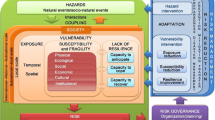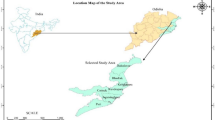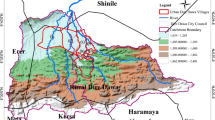Abstract
This study adopted a flood vulnerability index (FVI) to assess the flood vulnerability of ten villages in Mai Hoa Commune, a mountainous community living along Gianh River in Tuyen Hoa District, Quang Binh Province. The flood vulnerability indicators, which are grouped into Exposure, Susceptibility, and Resilience, were identified given the previous studies on FVI elsewhere and in consultation with local key informants. A questionnaire survey then was conducted with local households and key government staff to compute the FVI of the villages. The data were analyzed by Excel software and then flood vulnerability maps were created by the Quantum GIS software. The findings indicate that there are three villages at the high level, five at the moderate level, and two at the low level of flood vulnerability. The findings also reveal that the exposure indicators such as population in the flooded area and farmland in the flooded area, the susceptibility indicators such as vulnerable population, poverty rate and population with the main income from agriculture, and the resilience indicators such as external support for household disaster risk management, practices in flood risk management, financial capacity for recovery, social resources, and swimming skills, are the main determinants of village flood vulnerability. The findings further indicate that FVI can be used as an effective tool to compare determinants of flood vulnerability among the villages. It, accordingly, suggests priority actions specified to flood vulnerability reduction for the villages.





Similar content being viewed by others
References
Adger WN, Kelly PM (1999) Social vulnerability to climate change and the architecture of entitlements. Mitig Adapt Strat Glob Change 4(3–4):253–266
AHA Centre (2015) Country report—Vietnam. Natural disaster risk assessment and area business continuity plan formulation for industrial agglomerated areas in the ASEAN region
Antwi EK, Boakye-Danquah J, Barima Owusu A, Loh SK, Mensah R, Boafo YA, Apronti PT (2015) Community vulnerability assessment index for flood prone savannah agro-ecological zone: a case study of Wa West District, Ghana. Weather Clim Extrem 10:56–69. https://doi.org/10.1016/j.wace.2015.10.008
Balica S, Wright NG (2010) Reducing the complexity of the flood vulnerability index. Environ Hazards 9(4):321–339
Balica S, Wright NG, van der Meulen F (2012) A flood vulnerability index for coastal cities and its use in assessing climate change impacts. Nat Hazards 64(1):73–105
Birkmann J (ed) (2006) Measuring vulnerability to natural hazards: towards disaster resilient societies. United Nations University Press, New York
Cannon T (1994) Vulnerability analysis and the explanation of ‘natural’disasters. In: Varley A (ed) Disasters, development and environment. Wiley, Chichester, pp 13–30
Cardona OD (2013) The need for rethinking the concepts of vulnerability and risk from a holistic perspective: a necessary review and criticism for effective risk management. In: Bankoff G, Frerks G (eds) Mapping vulnerability. Disasters, development and people, 1st edn. Routledge, London, pp 56–70
Cardona OD, Van Aalst MK, Birkmann J, Fordham M, Mc Gregor G, Mechler R (2012) Determinants of risk: exposure and vulnerability. In: Field C, Barros V, Stocker T (eds) Managing the risks of extreme events and disasters to advance climate change adaptation. Cambridge University Press, Cambridge. https://doi.org/10.1017/CBO9781139177245.005
Connor RF, Hiroki K (2005) Development of a method for assessing flood vulnerability. Water Sci Technol 51(5):61–67
Gao J, Nickum JE, Pan Y (2007) An assessment of flood hazard vulnerability in the Dongting Lake Region of China. Lakes Reserv Res Manag 12(1):27–34
Huang D, Zhang R, Huo Z, Mao F, Youhao E, Zheng W (2012) An assessment of multidimensional flood vulnerability at the provincial scale in China based on the DEA method. Nat Hazards 64(2):1575–1586
IPCC (2014) Annex II: glossary. Climate change 2014: synthesis report. Contribution of working groups I, II and III to the fifth assessment report of the intergovernmental panel on climate change. Geneva, Switzerland
Khan S (2012) Vulnerability assessments and their planning implications: a case study of the Hutt Valley, New Zealand. Nat Hazards 64(2):1587–1607
Kissi AE, Abbey GA, Agboka K, Egbendewe A (2015) Quantitative assessment of vulnerability to flood hazards in downstream area of Mono Basin, South-Eastern Togo: Yoto District. J Geogr Inf Syst 7(06):607–619
Lewis J (1999) Development in disaster-prone places: studies of vulnerability. Practical Action Publishing, Rugby. https://doi.org/10.3362/9781780442013
Luu C, Von Meding J, Kanjanabootra S (2018) Flood risk management activities in Vietnam: a study of local practice in Quang Nam province. Int J Disaster Risk Reduct 28:776–787. https://doi.org/10.1016/j.ijdrr.2018.02.006
Mai Hoa Commune People’s Committee (2015a) Mai Hoa Socio-economic development report
Mai Hoa Commune People’s Committee (2015b) Mai Hoa vulnerability and capacity assessment
Merz B, Thieken AH, Gocht M (2007) Flood risk mapping at the local scale: concepts and challenges. In: Begum S, Stive MJ, Hall JW (eds) Flood risk management in Europe. Springer, Dordrecht, pp 231–251. https://doi.org/10.1007/978-1-4020-4200-3_13
Nasiri H, Yusof MJM, Ali TAM (2016) An overview to flood vulnerability assessment methods. Sustain Water Resour Manag 2(3):331–336
Rashetnia S (2016) Flood vulnerability assessment by applying a fuzzy logic method: a case study from Melbourne. PhD Thesis. Victoria University
Smit B, Wandel J (2006) Adaptation, adaptive capacity and vulnerability. Glob Environ Change 16(3):282–292
Smit B, Burton I, Klein RJT, Street R (1999) The science of adaptation: a framework for assessment. Mitig Adapt Strat Glob Change 4(3–4):199–213
Tingsanchali T (2012) Urban flood disaster management. Procedia Eng 32:25–37. https://doi.org/10.1016/j.proeng.2012.01.1233
Turner BL, Kasperson RE, Matson PA, McCarthy JJ, Corell RW, Christensen L et al (2003) A framework for vulnerability analysis in sustainability science. Proc Natl Acad Sci 100(14):8074–8079
Twigg J (2015) Disaster risk reduction. Overseas Development Institute, London, UK. https://goodpracticereview.org/wp-content/uploads/2015/10/GPR-9-web-string-1.pdf
UNISDR (2004) Living with risk: a global review of disaster reduction initiatives, vol 1. The United Nations International Strategy for Disaster Reduction, Geneva, Switzerland. https://www.unisdr.org/files/657_lwr1.pdf
UNISDR (2005) Hyogo framework for action 2005–2015: building the resilience of nations and communities to disasters. Extract from the final report of the World Conference on Disaster Reduction (A/CONF. 206/6) (vol 380). The United Nations International Strategy for Disaster Reduction, Geneva. https://www.unisdr.org/2005/wcdr/intergover/official-doc/L-docs/Hyogo-framework-for-action-english.pdf
UNISDR (2009) Global assessment report on disaster risk reduction. Risk and poverty in a changing climte: invest today for a saver tomorrow. The United Nations International Strategy for Disaster Reduction Geneva, Geneva
Villagran De Leon JC (2006) Vulnerability: a conceptual and methodological review. UNU Intstitute for Environment and Human Security, Bonn
Wallemacq P, Below R, McLean D (2018) UNISDR and CRED report: economic losses, poverty & disasters (1998–2017). Brussels, Belgium. https://www.cred.be/sites/default/files/CRED_Economic_Losses_10oct.pdf
Wisner B, Blaikie P, Cannon T, Davis I (2004) At risk: natural hazards, peoples vulnerability and disasters. Routledge, London
Acknowledgements
Our thanks go to German Red Cross, Vietnam Red Cross and all the participants in this study.
Author information
Authors and Affiliations
Corresponding author
Additional information
Publisher's Note
Springer Nature remains neutral with regard to jurisdictional claims in published maps and institutional affiliations.
Rights and permissions
About this article
Cite this article
Nguyen, C.T., Van Nguyen, B. Application of flood vulnerability index in flood vulnerability assessment: a case study in Mai Hoa Commune, Tuyen Hoa District, Quang Binh Province. Sustain. Water Resour. Manag. 5, 1917–1927 (2019). https://doi.org/10.1007/s40899-019-00337-y
Received:
Accepted:
Published:
Issue Date:
DOI: https://doi.org/10.1007/s40899-019-00337-y




